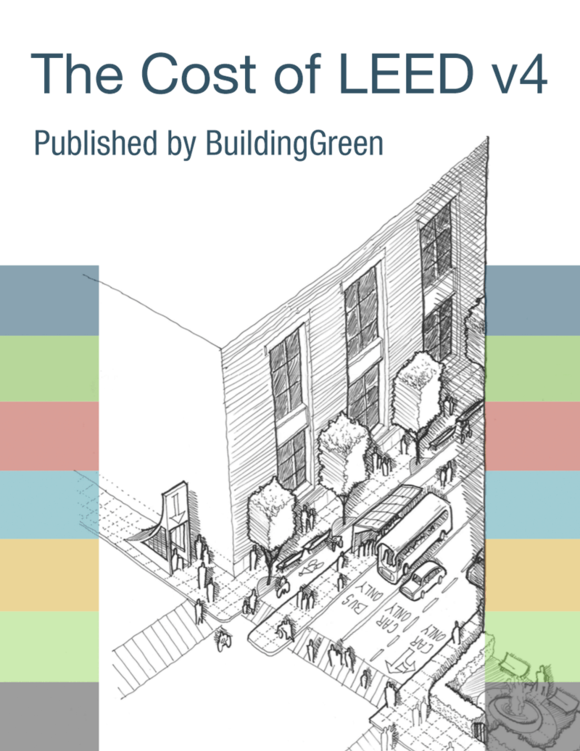"o Where local building code conflicts with LEED prescriptive requirements, project teams may select fixtures that comply with local code and compensate by selecting more water-efficient fixtures for other fixture types, provided that the flow rate for the fixture is the lowest allowable by code, and the project meets in aggregate the required 20% reduction from LEED baseline. Provide an excerpt of the local code highlighting the flow rate requirements when submitting for review."
LEEDuser’s viewpoint
Frank advice from LEED experts
LEED is changing all the time, and every project is unique. Even seasoned professionals can miss a critical detail and lose a credit or even a prerequisite at the last minute. Our expert advice guides our LEEDuser Premium members and saves you valuable time.
Credit language

© Copyright U.S. Green Building Council, Inc. All rights reserved.
Requirements
Building Water Use
For the fixtures and fittings listed in Table 1, as applicable to the project scope, reduce aggregate water consumption by 20% from the baseline. Base calculations on the volumes and flow rates shown in Table 1. All newly installed toilets, urinals, private lavatory faucets, and showerheads that are eligible for labeling must be WaterSense labeled (or a local equivalent for projects outside the U.S.).Table 1. Baseline water consumption of fixtures and fittings
| Commercial Fixtures, Fittings, and Appliances | Current Baseline (IP Units) | Current Baseline (SI units) |
|---|---|---|
| Water closets (toilets)* | 1.6 gallons per flush (gpf) | 6 liters per flush (lpf) |
| Urinal* | 1.0 (gpf) | 3.8 lpf |
| Public lavatory (restroom) faucet | 0.5 gpm at 60 psi all others except private applications | 1.9 lpm at 415 kPa, all others except private applications |
| Private lavatory faucet* | 2.2 gpm at 60 psi | 8.3 lpm at 415 kPa |
| Kitchen faucet (excluding faucets used exclusively for filling operations) | 2.2 gpm at 60 psi | 8.3 lpm at 415 kPa |
| Showerhead* | 2.5 gpm at 80 psi per shower stall | 9.5 lpm at 550 kPa per shower stall |
| * WaterSense label available for this product type gpf = gallons per flush gpm = gallons per minute psi = pounds per square inch lpf = liters per flush lpm = liters per minute kPa = kilopascals | ||
Appliance and Process Water Use
Install appliances, equipment, and processes within the project scope that meet the requirements listed in the tables below. Existing appliances intended for reuse in the project are not required to meet the requirements in Table 2.Appliance and process water use
Install appliances, equipment, and processes within the project scope that meet the requirements listed in the tables below .Table 2. Standards for appliances
| Appliance | Requirement |
|---|---|
| Residential clothes washers | ENERGY STAR or performance equivalent |
| Commercial clothes washers | ENERGY STAR or performance equivalent |
| Residential dishwashers (standard and compact) | ENERGY STAR or performance equivalent |
| Prerinse spray valves | ≤ 1.3 gpm (4.9 lpm) |
| Ice machine | ENERGY STAR or performance equivalent and use either air-cooled or closed-loop cooling, such as chilled or condenser water system |
lpm = liters per minute
Table 3. Standards for processes
| Process | Requirement |
|---|---|
| Heat rejection and cooling | No once-through cooling with potable water for any equipment or appliances that reject heat |
| Cooling towers and evaporative condensers | Equip with:
|
Table 4. Standards for appliances
| Kitchen equipment | Requirement (IP units) | Requirement (SI units) | |
|---|---|---|---|
| Dishwasher | Undercounter | ≤ 1.6 gal/rack | ≤ 6.0 liters/rack |
| Stationary, single tank, door | ≤ 1.4 gal/rack | ≤ 5.3 liters/rack | |
| Single tank, conveyor | ≤ 1.0 gal/rack | ≤ 3.8 liters/rack | |
| Multiple tank, conveyor | ≤ 0.9 gal/rack | ≤ 3.4liters/rack | |
| Flight machine | ≤ 180 gal/hour | ≤ 680 liters/hour | |
| Food steamer | Batch | ≤ 6 gal/hour/pan | ≤ 23 liters/hour/pan |
| Cook-to-order | ≤ 10 gal/hour/pan | ≤ 38 liters/hour/pan | |
| Combination oven | Countertop or stand | ≤ 3.5 gal/hour/pan | ≤ 13 liters/hour/pan |
| Roll-in | ≤ 3.5 gal/hour/pan | ≤ 13 liters/hour/pan | |
Table 5. Standards for processes
| Process | Requirement |
|---|---|
| Discharge water temperature tempering | Where local requirements limit discharge temperature of fluids into drainage system, use tempering device that runs water only when equipment discharges hot water OR Provide thermal recovery heat exchanger that cools drained discharge water below code-required maximum discharge temperatures while simultaneously preheating inlet makeup water OR If fluid is steam condensate, return it to boiler |
| Venturi-type flow-through vacuum generators or aspirators | Use no device that generates vacuum by means of water flow through device into drain |
What does it cost?
Cost estimates for this credit
On each BD+C v4 credit, LEEDuser offers the wisdom of a team of architects, engineers, cost estimators, and LEED experts with hundreds of LEED projects between then. They analyzed the sustainable design strategies associated with each LEED credit, but also to assign actual costs to those strategies.
Our tab contains overall cost guidance, notes on what “soft costs” to expect, and a strategy-by-strategy breakdown of what to consider and what it might cost, in percentage premiums, actual costs, or both.
This information is also available in a full PDF download in The Cost of LEED v4 report.
Learn more about The Cost of LEED v4 »Frequently asked questions
See all forum discussions about this credit »Addenda
"o Where local building code conflicts with LEED prescriptive requirements, project teams may select fixtures that comply with local code and compensate by selecting more water-efficient fixtures for other fixture types, provided that the flow rate for the fixture is the lowest allowable by code, and the project meets in aggregate the required 20% reduction from LEED baseline. Provide an excerpt of the local code highlighting the flow rate requirements when submitting for review."
"To reduce indoor potable water consumption and preserve no and low cost potable water resources."
"Campus or Municipal Alternative Water Sources
Projects may count future infrastructure for reclaimed water systems in Water Efficiency credit calculations if:
the future systems will be functional within 2 years of project occupancy,
the project provides documentation, such as a signed contract, confirming that the reclaimed water will be provided to the project within a 2-year period from project occupancy, and
the project provides confirmation that the reclaimed water supplier has agreed to supply the volume of treated wastewater or seawater claimed by the project."
Revise the sentence below Table 2. Standards for appliances so that it reads as follows: "*Projects in Europe may install residential appliances meeting the EU A label."
"The EU A label for residential appliances is an acceptable alternative to ENERGY STAR. The EU Ecodesign and Labelling framework establishes minimum performance standards for the energy and environmental performance of appliances and products."
"Exemplary Performance
Achieve 55% savings."
Documentation toolkit
The motherlode of cheat sheets
LEEDuser’s Documentation Toolkit is loaded with calculators to help assess credit compliance, tracking spreadsheets for materials, sample templates to help guide your narratives and LEED Online submissions, and examples of actual submissions from certified LEED projects for you to check your work against. To get your plaque, start with the right toolkit.
Get the inside scoop
Our editors have written a detailed analysis of nearly every LEED credit, and LEEDuser premium members get full access. We’ll tell you whether the credit is easy to accomplish or better left alone, and we provide insider tips on how to document it successfully.

© Copyright U.S. Green Building Council, Inc. All rights reserved.
Requirements
Building Water Use
For the fixtures and fittings listed in Table 1, as applicable to the project scope, reduce aggregate water consumption by 20% from the baseline. Base calculations on the volumes and flow rates shown in Table 1. All newly installed toilets, urinals, private lavatory faucets, and showerheads that are eligible for labeling must be WaterSense labeled (or a local equivalent for projects outside the U.S.).Table 1. Baseline water consumption of fixtures and fittings
| Commercial Fixtures, Fittings, and Appliances | Current Baseline (IP Units) | Current Baseline (SI units) |
|---|---|---|
| Water closets (toilets)* | 1.6 gallons per flush (gpf) | 6 liters per flush (lpf) |
| Urinal* | 1.0 (gpf) | 3.8 lpf |
| Public lavatory (restroom) faucet | 0.5 gpm at 60 psi all others except private applications | 1.9 lpm at 415 kPa, all others except private applications |
| Private lavatory faucet* | 2.2 gpm at 60 psi | 8.3 lpm at 415 kPa |
| Kitchen faucet (excluding faucets used exclusively for filling operations) | 2.2 gpm at 60 psi | 8.3 lpm at 415 kPa |
| Showerhead* | 2.5 gpm at 80 psi per shower stall | 9.5 lpm at 550 kPa per shower stall |
| * WaterSense label available for this product type gpf = gallons per flush gpm = gallons per minute psi = pounds per square inch lpf = liters per flush lpm = liters per minute kPa = kilopascals | ||
Appliance and Process Water Use
Install appliances, equipment, and processes within the project scope that meet the requirements listed in the tables below. Existing appliances intended for reuse in the project are not required to meet the requirements in Table 2.Appliance and process water use
Install appliances, equipment, and processes within the project scope that meet the requirements listed in the tables below .Table 2. Standards for appliances
| Appliance | Requirement |
|---|---|
| Residential clothes washers | ENERGY STAR or performance equivalent |
| Commercial clothes washers | ENERGY STAR or performance equivalent |
| Residential dishwashers (standard and compact) | ENERGY STAR or performance equivalent |
| Prerinse spray valves | ≤ 1.3 gpm (4.9 lpm) |
| Ice machine | ENERGY STAR or performance equivalent and use either air-cooled or closed-loop cooling, such as chilled or condenser water system |
lpm = liters per minute
Table 3. Standards for processes
| Process | Requirement |
|---|---|
| Heat rejection and cooling | No once-through cooling with potable water for any equipment or appliances that reject heat |
| Cooling towers and evaporative condensers | Equip with:
|
Table 4. Standards for appliances
| Kitchen equipment | Requirement (IP units) | Requirement (SI units) | |
|---|---|---|---|
| Dishwasher | Undercounter | ≤ 1.6 gal/rack | ≤ 6.0 liters/rack |
| Stationary, single tank, door | ≤ 1.4 gal/rack | ≤ 5.3 liters/rack | |
| Single tank, conveyor | ≤ 1.0 gal/rack | ≤ 3.8 liters/rack | |
| Multiple tank, conveyor | ≤ 0.9 gal/rack | ≤ 3.4liters/rack | |
| Flight machine | ≤ 180 gal/hour | ≤ 680 liters/hour | |
| Food steamer | Batch | ≤ 6 gal/hour/pan | ≤ 23 liters/hour/pan |
| Cook-to-order | ≤ 10 gal/hour/pan | ≤ 38 liters/hour/pan | |
| Combination oven | Countertop or stand | ≤ 3.5 gal/hour/pan | ≤ 13 liters/hour/pan |
| Roll-in | ≤ 3.5 gal/hour/pan | ≤ 13 liters/hour/pan | |
Table 5. Standards for processes
| Process | Requirement |
|---|---|
| Discharge water temperature tempering | Where local requirements limit discharge temperature of fluids into drainage system, use tempering device that runs water only when equipment discharges hot water OR Provide thermal recovery heat exchanger that cools drained discharge water below code-required maximum discharge temperatures while simultaneously preheating inlet makeup water OR If fluid is steam condensate, return it to boiler |
| Venturi-type flow-through vacuum generators or aspirators | Use no device that generates vacuum by means of water flow through device into drain |


